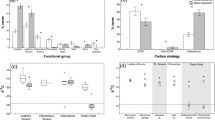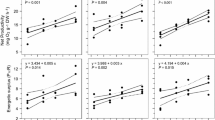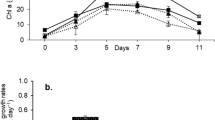Abstract
Photosynthetic rates of aquatic plants frequently increase with increasing current velocities. This is presumably due to a reduction in the thickness of the diffusion boundary-layer which allows for a higher carbon availability on the plant surface. Blades of the seagrasses Thalassia testudinum and Cymodocea nodosa exposed to different current velocities under controlled laboratory conditions, showed increased photosynthetic rates with increasing flow only at low current velocities (expressed as blade friction velocities, u *). Carbon saturation of photosynthetic processes occurred at a relatively low u * level (0.25 cm s-1) for T. testudinum collected from a calm environment compared to C. nodosa (0.64 cm s-1) collected from a surf zone. No further enhancement of photosynthetic rates was observed at higher u * levels, suggesting limitations in carbon diffusion through the boundary layer below critical u * levels and possible limitations in carbon fixation by the enzymatic system at higher u * levels. These results, as well as those of previous theoretical studies, assumed the flow on the immediate seagrass-blade surface to be hydrodynamically smooth. The presence of epiphytes and attached debris causes the surface of in situ seagrass blades to be exposed to flows ranging from smooth to rough-turbulent. As a consequence, the boundary-layer thickness on moderately epiphytized blades under medium to high flow-conditions is not continuous, but fluctuates in time and space, enhancing carbon transport. In situ u * levels measured directly on blades of seagrasses indicate that T. testudinum and C. nodosa can be exposed to conditions under which the boundary layer limits photosynthesis during short periods of time (milliseconds) during low-energy events. As waves cause the thickness of the diffusion boundary-layer to fluctuate constantly, carbon-limiting conditions do not persist for prolonged periods.
Similar content being viewed by others
References
Adams, M. S., Guilizzoni, P., Adams, S. (1978). Relationship of dissolved inorganic carbon to macrophyte photosynthesis in some Italian lakes. Limnol. Oceanogr. 23: 912–919
Ackerman, J. D., Okubo, A. (1993). Reduced mixing in a marine macrophyte canopy. Funct. Ecol. 7: 305–309
Axelsson, L., Carlberg, S., Larsson, C., Ryberg, H., Uusitalo, J. (1990). CO2 storage and CO2 concentrating in brown seaweeds. III. A tentative working model. In: Baltscheffsky, M. (ed.) Current research in photosynthesis. Kluwer Academic Publishers, Dordrecht, p. 525–528
Beer, S. (1989). Photosynthesis and photorespiration of marine angiosperms. Aquat. Bot. 34: 153–166
Beer, S., Shomer-Ilan, A., Waisel, Y. (1980). Carbon metabolism in seagrasses. II. Patterns of photosynthetic CO2 incorporation. J. exp. Bot. 31: 1019–1026
Boston, H. L., Adams, M. S., Madsen, J. D. (1989). Photosynthetic strategies and productivity in aquatic systems. Aquat. Bot. 34: 27–57
Conover, J. T. (1966). The importance of natural diffusion gradients and transport of substances related to benthic marine plant metabolism. Botanica mar. 11: 1–9
Cooper, L. W., McRoy, C. P. (1988). Anatomical adaptations to rocky substrates and surf exposure by the seagrass genus Phyllospadix. Aquat. Bot. 32: 365–381
Dawes, C. J. (1989). Introduction to electron microscopy: theory and techniques. Ladd Research Industries, Inc., Burlington, Vermont, USA
Durako, M. J. (1991). Carbon dynamics of the seagrass Thalassia testudinum. PhD dissertation. University of South Florida, St. Petersburg
Durako, M. J. (1993). Photosynthetic utilization of CO2(aq) and HCO -3 in Thalassia testudinum (Hydrocharitaceae). Mar. Biol. 115: 373–380
Durako, M. J., Hall, M. O. (1992) Effects of light on the stable carbon isotope composition of the seagrass Thalassia testudinum. Mar. Ecol. Prog. Ser. 86: 99–101
Fonseca, M. S., Kenworthy, J. (1987). Effects of current on photosynthesis and distribution of seagrasses. Aquat. Bot. 27: 59–78
Gust, G. (1988). Skin friction probes for field applications. J. geophys. Res. 93: 14,121–14,132
Hartog, C., den (1970) The seagrasses of the world. North-Holland Publishing Co., Amsterdam
Hicks, C. R. (1982). Fundamental concepts in the design of experiments. Holt, Rinehart & Winston, New York
Huettel, M., Gust, G. (1992). Solute release mechanism from confined sediment cores in stirred benthic chambers and flume flows. Mar. Ecol. Prog. Ser. 82: 187–197
Jumars, P. A., Nowell, A. R. M. (1984). Fluid and sediment dynamic effects on marine benthic community structure. Am. Zool. 24: 45–55
Kirk, J. T. O. (1983). Light and photosynthesis in aquatic ecosystems. Cambridge University Press, New York
Koch, E. W., Gust, G. (1991). Near stagnant waters as a disturbance to the seagrass Thalassia testudinum. In: Abstracts of the 11th International Estuarine Research Conference, San Francisco (Unpublished)
Koehl, M. A. R., Alberte, R. S. (1988). Flow, flapping and photosynthesis of Nereocystis luetkeanna: a functional comparison of undulate and flat blade morphologies. Mar. Biol. 99: 435–444
Koehl, M., Worcester, S. E. (1991). Effects of seagrass on water flow at several biologically-important spatial scales. In: Abstracts of the 11th International Estuarine Research Conference, San Francisco (Unpublished)
Larkum, A. W. D., Roberts, G., Kuo, J., Strother, S. (1989). Gaseous movement in seagrasses. In: Larkum, A. W. D., McComb, A. J., Shepherd, S. A. (eds.) Biology of seagrasses — a treatise on the biology of seagrasses with special reference to the Australian region. Elsevier, New York, p. 686–722
Lipkin, Y. (1977). Seagrass vegetation of Sinai and Israel. In: McRoy, C. P., Helferich, C. (eds.) Seagrass ecosystems — a scientific perspective. Marcel Dekker, Inc., New York, p. 263–293
Lucas, W. L. (1983). Photosynthetic assimilation of exogenous HCO3 by aquatic plants. A. Rev. Pl. Physiol. 34: 71–104
Nikuradse, J. (1933). Laws of flow in rough pipes. Tech. Memo. natn. advis. Comm. Aeronaut., Wash. 1292: 1–62 [transl. from German, 1950]
Nowell, A. R. M., Jumars, P. A. (1984). Flow environments of aquatic benthos. A. Rev. Ecol. Syst. 15: 303–328
Opdyke, B. N., Gust, G., Ledwell, J. R. (1987). Mass transfer from smooth alabaster surfaces in turbulent flow. Geophys. Res. Lett. 14: 1131–1134
Parker, H. S. (1981). Influence of relative water motion on the growth, ammonium uptake and carbon and nitrogen composition of Ulva lactuca (Chlorophyta). Mar. Biol. 63: 309–318
Prins, H. B. A., Elzenga, J. T. M. (1989). Bicarbonate utilization: function and mechanism. Aquat. Bot. 34: 59–83
Raven, J. A. (1991). Implications of inorganic carbon utilization: ecology, evolution, and geochemistry. Can. J. Bot. 69: 908–924
Raven, J. A., Richardson, K. (1986). Marine environments. In: Baker, N. R., Long, S. P. (eds.) Photosynthesis in contrasting environments. Elsevier Science Publishers, Berlin, p. 337–398
Sand-Jensen, K., Revsbech N. P., Jørgensen, B. B. (1985). Microprofiles of O2 in epiphyte communities on submerged macrophytes. Mar. Biol. 89: 55–62
SAS Institute Inc. (1985). SAS user's guide: statistics. Version 5 edn. SAS Institute Inc., Cary, North Carolina
Smith, F. A., Walker, N. A. (1980). Photosynthesis by aquatic plants: effects of unstirred layers in relation to assimilation of CO2 and HCO -3 and to carbon isotopic discrimination. New Phytol. 86: 245–259
Sokal, R. R., Rohlf, F. J. (1981). Biometry. The principles and practice of statistics in biological research. W. H. Freeman & Co., New York
Van der Velde, G., den Hartog, C. (1992). Continuing range extension of Halophila stipulacea (Forssk.) Aschers. (Hydrocharitaceae) in the Mediterranean — now found at Kefallina and Ithaki (Ionian Sea). Acta bot. neerl. 41: 345–348
Vogel, A. I. (1961) A textbook of quantitative inorganic analysis including elementary instrumental analysis. 3rd edn. Longmans, Green & Co., London
Vogel, S. (1989). Life in moving fluids — the physical biology of flow. University Press, Princeton
Wheeler, W.N. (1980). Effect of boundary layer transport on the fixation of carbon by the giant kelp Macrocystis pyrifera. Mar. Biol. 56: 103–110
Whitford, L. A., Kim, C. S. (1966). The effect of light and water movement on some species of marine algae. Revue algol. 3: 251–254
Author information
Authors and Affiliations
Additional information
Communicated by N. H. Marcus, Tallahassee
Rights and permissions
About this article
Cite this article
Koch, E.W. Hydrodynamics, diffusion-boundary layers and photosynthesis of the seagrasses Thalassia testudinum and Cymodocea nodosa . Marine Biology 118, 767–776 (1994). https://doi.org/10.1007/BF00347527
Received:
Accepted:
Issue Date:
DOI: https://doi.org/10.1007/BF00347527




